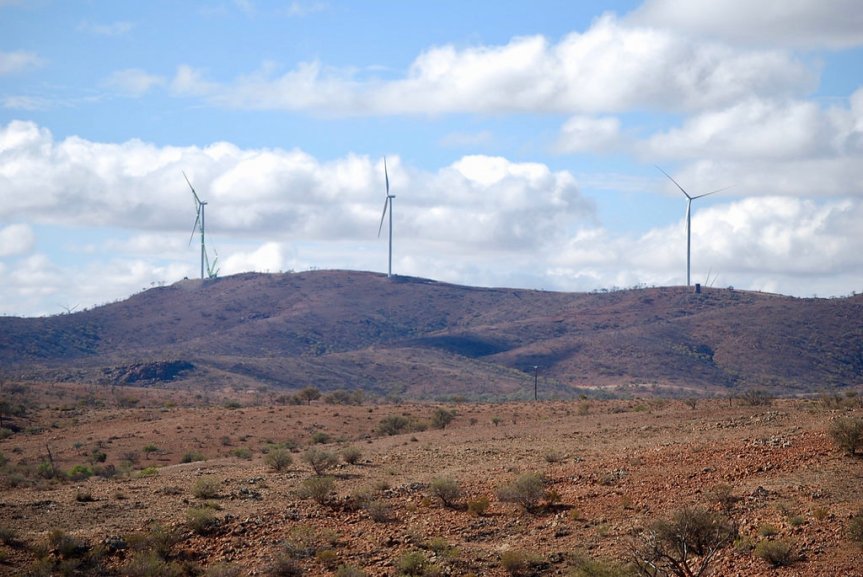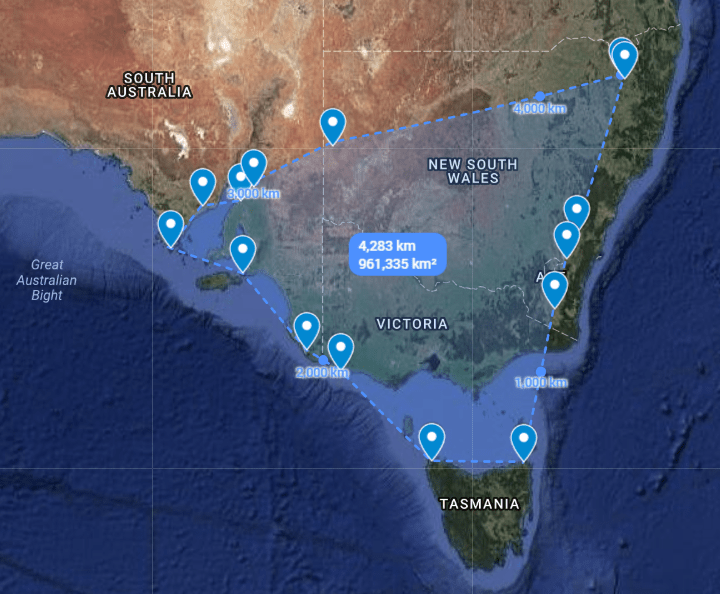The Australian wind industry has a habit of spearing its turbines way beyond the back of beyond. Increasingly remote wind farm locations require serious upgrades to transmission infrastructure, adding hundreds of $millions to transmission costs, that would have otherwise been avoided, had Australia simply stuck with conventional generators and not squandered $60,000,000,000 in subsidies to intermittent wind and solar.
As any first-year physics student will tell you, transmitting electricity over distances results in a mathematically predictable loss of the power transmitted, over any given distance. The greater the distance, the greater the absolute loss.
Just like the value of prime real estate, the most beneficial situation for generating capacity is all about location, location, location.
In the main, conventional generators are sited close enough to the majority of the load (i.e. power consumers) – such that the transmission losses involved amount to relative trickles. Not so with the roughly 5,600 MW of wind power capacity connected to the Eastern Grid.
On the Eastern Grid, Australia’s wind farms are located in 4 States – Tasmania, South Australia, Victoria and NSW – and spread from: Hornsdale in the Mid-North, west to Cathedral Rocks on lower Eyre Peninsula and south to Millicent in the South-East of South Australia; down to Cape Portland (Musselroe) and Woolnorth (Cape Grim) in Tasmania; all over Victoria; and in New South Wales, at Broken Hill (Sliverton) in the far west, and right up to Glen Innes in the New England Ranges.
There are over 1,800 turbines in 80 odd wind farms (which range from 20-30 turbine clusters right up to the largest collection of 140 at Macarthur in Western Victoria) – that are spread out over a geographical expanse of 961,335 km².
That’s an area which is 4.19 times the combined area of England (130,395 km²) Scotland (78,387 km²) and Wales (20,761 km²) of 229,543 km². Or 1.75 times the 551,394 km² covered by France.
Wind power outfits – which have hitherto suffered no financial consequence for sticking their monsters in the outback – have just been slammed with a little physical reality: the grid manager isn’t prepared to pay for electricity that doesn’t actually satisfy market demand. In other words, customers shouldn’t have to pay for power that never gets delivered, at all.
Predictably enough, however, the wind industry is crying blue murder. Another case of all ‘care’ and no responsibility.
Projects face suppressed revenues in Australia
Wind Power Monthly
David Weston
8 March 2019
Wind projects in Australia are facing a reduction in project revenues following a change in the Marginal Loss Factors (MLF) for 2019-20 for the country’s generators.
The Australian Energy Market Commission (AEMC) has released its draft MLF for 2019-20.
MLFs represent the loss of electricity along transmission cables and power lines as a result of “resistive heating”, the Australian Energy Market Operator (AEMO) said.
The factor is a percentage of the generation from a plant that reaches an end user. Generators are paid for the amount of electricity delivered, rather than produced.
A reduced MLF — or more losses incurred on the grid — means less revenue. MLFs are set annually by AEMO and AEMC. AEMO said the figures were predictions and still subject to change.
All generators are affected, but it is believed wind and solar sources are more adversely affected due to not being located at load centres, meaning more transmission distance, equaling greater loss.
Some projects, such as AGL’s Silverton Wind Farm could see its MLF fall from 1.0062 to 0.799, resulting in a 20% fall in power being delivered to end users, causing lower project revenues.
Most wind and solar projects are projected to see a 5% fall in MLF, while few could increase.
The Clean Energy Council (CEC) called for a review of the MLF system, which it claimed was outdated and could put future investment at risk, if project revenues prediction was uncertain.
“The biggest challenge for the industry is that we have experienced significant and unexpected annual decreases in MLFs for the last few years,” said Kane Thornton, chief executive at CEC.
“MLFs represent the loss of electricity as it travels from power generators along poles and wires to customers.
“While this is a complex issue, the consequences are simple — an unexpected and unpredictable reduction in the viability of wind, solar, hydro and bioenergy projects across the country.
“The MLF methodology was established over 20 years ago and is no longer fit for purpose. A comprehensive and holistic review of MLFs by the AEMC is imperative, along with considerations of how this volatility could be controlled in the short term.
“The industry is calling on the AEMC to complete this review as soon as possible.
“The issue also underlines the need for efficient investment in new poles and wires to relieve the strain on the existing network, which is rapidly becoming congested. This remains one of the highest priorities for our industry,” Thornton added.
Wind Power Monthly



But, isn’t it great these monstrosities are far from people, so they won’t disturb anyone’s sleep or make them sick?
From the quoted article;
“Some projects, such as AGL’s Silverton Wind Farm could see its MLF fall from 1.0062 to 0.799, resulting in a 20% fall in power being delivered to end users, causing lower project revenues.”
They really try to claim this? Someone changes a number somewhere and suddenly a wind farm delivers less power?
Serious Unicorn and Rainbow stuff there.
I put it to the original author instead that they are still delivering EXACTLY the same power as before the MLF (ie Not Much) only now you are being told you can’t charge as much.
Dry your eyes, Princess.
When you take Power Factor, Resistance, Impedance and Capacitance into account the wind farms placed hundred’s of kilometers away from the load centers might actually be supplying very little or no real power to consumers at all. The coal fired base load generators also act like large capacitance sinks that keep the Power Factor at a reasonable number and help stabilize the power being delivered. With the closing down of all the large coal fired generators any ability of humans being able to have any control on the quality of power being delivered will end. An electricity generating system using only unstable uncontrolled wind generators and a large amount of solar panels will be too unstable for any transmission protection to work. The inherent fluctuations and harmonics that would be generated and keep escalating until the whole system collapsed or serious damage was done to Transformers, VT’s, CT’s Reactors, and transmission line protection. To even come up with a system like the one being planed is total nonsense and stupidity taken to it’s limit by people with no knowledge of generating electricity at all.
When you take Power Factor, Resistance, Impedance and Capacitance into account the wind farms placed hundred’s of kilometers away from the load centers might actually be supplying very little or no real power to consumers at all. The coal fired base load generators also act like large capacitance sinks that keep the Power Factor at a reasonable number and help stabilize the power being delivered. With the closing down of all the large coal fired generators any ability of humans being able to have any control on the quality of power being delivered will end. An electricity generating system using only unstable uncontrolled wind generators and a large amount of solar panels will be too unstable for any transmission protection to work. The inherent fluctuations and harmonics that would be generated and keep escalating until the whole system collapsed or serious damage was done to Transformers, VT’s, CT’s Reactors, and transmission line protection without the whole system being tied down by large human controlled generators is too mind bending to contemplate. To even come up with a system like the one being planed is total nonsense and stupidity taken to it’s limit by people with no knowledge of generating and transmitting electricity at all.
Reblogged this on ajmarciniak.
Like trying to harness together a thousand fractious cats using bits of string and about as useful.
The twin cyclones in the east and west of northern Australia with cloud covering most of the continent, shows how absolutely stupid are the idiotic calls for more wind turbines, batteries and massive solar arrays covering productive agricultural land. The manipulative use of children is deplorable!
With suburban roof arrays making house fires dangerous to fight because of electric shock, if a fire breaks out in a street full of solar paneled houses will they all have to be left to burn out spreading carcinogens over a region as BP Solar did in Germany and then did a runner just like James Hardie Industries did here?
As long as the nuclear plant at Lucas Heights keeps operating it makes the main political parties hypocrites. That it produces medical isotopes is immaterial; it is an operating nuclear facility, that makes a mockery of the NO NUCLEAR POLICY. Just as exporting coal and uranium is hypocritical.
How many reliable nuclear plants could have been built with the incredible RE subsidy so far, and everyone seems to have forgotten that during Hurricane Katrina a nuclear plant kept operating with no problems what-so-ever.
Will there be more off-shore Turbines with uncountable soil washed and blown into the seas, plus the rest, with all the hysteria of sea level rise yet no mention of water displacement that started before humans existed.
If land is so limited and precious, nations should be building more islands.
Electricity travels along poles does it? As quoted from Wind Power Monthly: Goes to show the mentality.
As the saying goes – When can you tell a politician is lying? When their lips move.
It’s about time this dinosaur of a political system was euthanised.
That is the logical result of using Wind. The more wind you use the longer your transmission lines get. The same is happening in Scotland.
The next question. Does the wind farm developer earn RECs based on what is fed into the grid or some lesser amount based on useable power at the load?
LGCs are issued on the dispatch of eligible sources, eg wind, to the grid at the point of generation.
Here is a reference to a report on the NEM based upon the System Levelized Cost of Electricity (SLCOE) as opposed to the intellectually dishonest Levelized Cost of Electricity (LCOE).
It shows the SLCOE of a 100% grid to be $AUD 415.50 per MWh
https://epc.com.au/index.php/nem-model/?fbclid=IwAR1ypSAwnw4hwNCZbgutDQTe3G0HCK8-nTFUtokbeKwTGDOC4rkYDX9fs5A